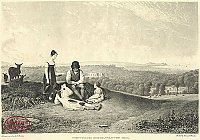 |
|
Francis Danby1793 – 1861 |
|
|
Click on a picture for more details |
|
|
The Irish born artist Francis Danby is considered to have been the leading painter of the Bristol School of artists during the Romantic period. Francis Danby had settled in Bristol in 1813 and over the next eleven years established himself as the finest landscape painter in the vicinity. During most of this time he painted in watercolours and it was only around 1818-19 that his work in oils began to emerge, his first major oil painting being exhibited in London at the British Institution in 1820 (The Upas Tree). By 1824 Francis Danby was heavily in debt and he fled the city of Bristol in secrecy, moving to the capital in the hope of fame and fortune. It was upon exhibition of his painting of Sunset at Sea after a Storm at the Royal Academy in 1824 that Francis Danby first rose to prominence in the London art scene. Regarded by Richard Redgrave as the “work that made the painter’s reputation” Sunset at Sea after a Storm was purchased to much fanfare at the exhibition by the President of the Royal Academy, Sir Thomas Lawrence. Here was a romantic seascape, which displayed that sublime depiction of limitless scale which John Martin had been using to such public acclaim. John Martin had already declared his opposition to the Royal Academy, but now the Academy appeared to have found its answer to John Martin’s spectacular triumphs through the art of Francis Danby. Unfortunately, Francis Danby was plagued by financial and marital problems throughout his life and although he rose to considerable fame through his paintings emulating the style of John Martin, he fled England for Europe in late 1829 as a result of the breakdown of his marriage and continued debt. Although he returned to England around a decade later he never re-established the fame which he had attained during the 1820’s. In recent times Francis Danby’s work has been re-appraised and he is now acknowledged for his remarkable ability as a landscape artist rather than just for the few dramatic oils paintings through which he first rose to fame. [more] |



